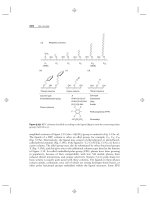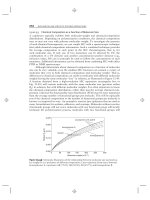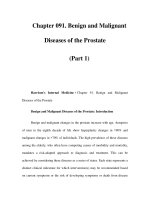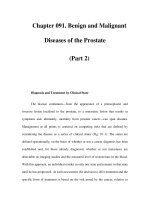Chapter 113. Introduction to Infectious Diseases: Host–Pathogen Interactions (Part 2) docx
Bạn đang xem bản rút gọn của tài liệu. Xem và tải ngay bản đầy đủ của tài liệu tại đây (61.23 KB, 13 trang )
Chapter 113. Introduction to Infectious Diseases:
Host–Pathogen Interactions
(Part 2)
Host Factors in Infection
For any infectious process to occur, the pathogen and the host must first
encounter each other. Factors such as geography, environment, and behavior thus
influence the likelihood of infection. Although the initial encounter between a
susceptible host and a virulent organism frequently results in disease, some
organisms can be harbored in the host for years before disease becomes clinically
evident. For a complete view, individual patients must be considered in the context
of the population to which they belong. Infectious diseases do not often occur in
isolation; rather, they spread through a group exposed from a point source (e.g., a
contaminated water supply) or from one individual to another (e.g., via respiratory
droplets). Thus, the clinician must be alert to infections prevalent in the
community as a whole. A detailed history, including information on travel,
behavioral
factors,
exposures
to
animals
or
potentially
contaminated
environments, and living and occupational conditions, must be elicited. For
example, the likelihood of infection by Plasmodium falciparum can be
significantly affected by altitude, climate, terrain, season, and even time of day.
Antibiotic-resistant strains of P. falciparum are localized to specific geographic
regions, and a seemingly minor alteration in a travel itinerary can dramatically
influence the likelihood of acquiring chloroquine-resistant malaria. If such
important details in the history are overlooked, inappropriate treatment may result
in the death of the patient. Likewise, the chance of acquiring a sexually
transmitted disease can be greatly affected by a relatively minor variation in sexual
practices, such as the method used for contraception. Knowledge of the
relationship between specific risk factors and disease allows the physician to
influence a patient's health even before the development of infection by
modification of these risk factors and—when a vaccine is available—by
immunization.
Many specific host factors influence the likelihood of acquiring an
infectious disease. Age, immunization history, prior illnesses, level of nutrition,
pregnancy, coexisting illness, and perhaps emotional state all have some impact on
the risk of infection after exposure to a potential pathogen. The importance of
individual host defense mechanisms, either specific or nonspecific, becomes
apparent in their absence, and our understanding of these immune mechanisms is
enhanced by studies of clinical syndromes developing in immunodeficient patients
(Table 113-1). For example, the higher attack rate of meningococcal disease
among people with deficiencies in specific complement proteins of the so-called
membrane attack complex (see "Adaptive Immunity," below) than in the general
population underscores the importance of an intact complement system in the
prevention of meningococcal infection.
Table 113-1 Infections Associated with Selected Defects in Immunity
Host Defect
Disease
or
Therapy
Associated with Defect
Common
Etiologic
Agent
of
Infection
NONSPECIFIC IMMUNITY
Impaired cough
Rib
fracture,
neuromuscular dysfunction
Bacteria
causing
pneumonia, aerobic and
anaerobic oral flora
Loss of gastric
acidity
Achlorhydria, histamine
blockade
Loss
of
Penetrating
Salmonella
spp.,
enteric pathogens
trauma,
Staphylococcus
cutaneous integrity
athlete's foot
Burn
spp., Streptococcus spp.
Pseudomonas
aeruginosa
Intravenous catheter
Staphylococcus
spp., Streptococcus spp.,
gram-negative
rods,
coagulase-negative
staphylococci
Implantable
Heart valve
device
Streptococcus spp.,
coagulase-negative
staphylococci,
Staphylococcus aureus
Artificial joint
Staphylococcus
spp., Streptococcus spp.,
gram-negative rods
Loss of normal
Antibiotic use
Clostridium
bacterial flora
difficile, Candida spp.
Impaired
clearance
Poor drainage
Urinary tract infection
Escherichia coli
Abnormal
Cystic fibrosis
Chronic pulmonary
secretions
infection
with
P.
aeruginosa
INFLAMMATORY RESPONSE
Neutropenia
Hematologic
malignancy,
Gram-negative
cytotoxic enteric
bacilli,
chemotherapy, aplastic anemia, Pseudomonas
spp.,
HIV infection
spp.,
Staphylococcus
Candida spp.
Chemotaxis
Chédiak-Higashi
syndrome,
Job's
S.
syndrome, Streptococcus
aureus,
pyogenes,
protein-calorie malnutrition
Haemophilus influenzae,
gram-negative bacilli
Leukocyte
adhesion
defects 1 and 2
Bacteria
causing
and
systemic
skin
infections, gingivitis
Phagocytosis
(cellular)
Systemic
lupus
Streptococcus
erythematosus (SLE), chronic pneumoniae,
myelogenous
H.
leukemia, influenzae
megaloblastic anemia
Splenectomy
—
H. influenzae, S.
pneumoniae,
other
streptococci,
Capnocytophaga
Babesia
spp.,
microti,
Salmonella spp.
Microbicidal
defect
Chronic granulomatous
disease
Catalase-positive
bacteria
and
fungi:
staphylococci,
E.
coli,
Klebsiella
spp.,
P.
aeruginosa,
Aspergillus
spp., Nocardia spp.
Chédiak-Higashi
S.
syndrome
γreceptor
interleukin
deficiency,
S.
pyogenes
Interferon
defect,
aureus,
interleukin
Mycobacterium
12 spp., Salmonella spp.
12
receptor defect
INNATE IMMUNITY
Complement system
C3
Congenital liver disease,
SLE, nephrotic syndrome
S.
aureus,
S.
pneumoniae,
Pseudomonas
Proteus spp.
spp.,
C5
Congenital
Neisseria
spp.,
gram-negative rods
C6, C7, C8
Congenital, SLE
Neisseria
meningitidis,
N.
gonorrhoeae
Alternative
Sickle cell disease
pathway
pneumoniae,
Salmonella spp.
Toll-like
Congenital
receptor 4
Interleukin
S.
Gram-negative
bacilli
1
Congenital
receptor–associated
S. pneumoniae, S.
aureus, other bacteria
kinase (IRAK) 4
Mannan-binding
lectin
Congenital
N.
other bacteria
meningitidis,
ADAPTIVE IMMUNITY
T
lymphocyte
Thymic aplasia, thymic
Listeria
deficiency/dysfunction hypoplasia, Hodgkin's disease, monocytogenes,
sarcoidosis,
lepromatous Mycobacterium
leprosy
spp.,
Candida spp., Aspergillus
spp.,
Cryptococcus
neoformans,
herpes
simplex virus, varicellazoster virus
AIDS
Pneumocystis,
cytomegalovirus,
herpes
simplex
Mycobacterium
virus,
avium-
intracellulare,
neoformans,
C.
Candida
spp.
Mucocutaneous
Candida spp.
candidiasis
Purine
nucleoside
Fungi, viruses
phosphorylase deficiency
B
cell
Bruton's
X-linked
deficiency/dysfunction agammaglobulinemia
S.
pneumoniae,
other streptococci
Agammaglobulinemia,
H. influenzae, N.
chronic lymphocytic leukemia, meningitidis, S. aureus,
multiple
myeloma, Klebsiella pneumoniae, E.
dysglobulinemia
coli,
Giardia
lamblia, Pneumocystis,
enteroviruses
Selective
IgM
deficiency
Selective IgA deficiency
S. pneumoniae, H.
influenzae, E. coli
G.
hepatitis
pneumoniae,
lamblia,
virus,
S.
H.
influenzae
Mixed T and B
cell
Common
variable
hypogammaglobulinemia
Pneumocystis,
S.
pneumoniae,
deficiency/dysfunction
cytomegalovirus,
H.
influenzae, various other
bacteria
Ataxia-telangiectasia
S. pneumoniae, H.
influenzae,
S.
aureus,
rubella virus, G. lamblia
Severe
combined
immunodeficiency
S.
aureus,
pneumoniae,
influenzae,
albicans,
S.
H.
Candida
Pneumocystis,
varicella-zoster
virus,
rubella
virus,
cytomegalovirus
Wiskott-Aldrich
Agents
of
syndrome
infections associated with
T and B cell abnormalities
X-linked
syndrome
hyper-IgM
Pneumocystis,
cytomegalovirus,
Cryptosporidium parvum
Medical care itself increases the patient's risk of acquiring an infection in
several ways: (1) through contact with pathogens during hospitalization, (2)
through breaching of the skin (with intravenous devices or surgical incisions) or
mucosal surfaces (with endotracheal tubes or bladder catheters), (3) through
introduction of foreign bodies, (4) through alteration of the natural flora with
antibiotics, and (5) through treatment with immunosuppressive drugs.
Infection involves complicated interactions of microbe and host and
inevitably affects both. In most cases, a pathogenic process consisting of several
steps is required for the development of infections. Since the competent host has a
complex series of barricades in place to prevent infection, the successful pathogen
must use specific strategies at each of these steps. The specific strategies used by
bacteria, viruses, and parasites (Chap. 114) have some remarkable conceptual
similarities, but the strategic details are unique not only for each class of
microorganism but also for individual species within a class.









